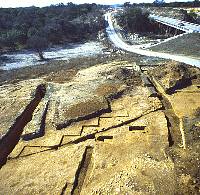
View west across central area of
Paleoindian dig at its conclusion.
|
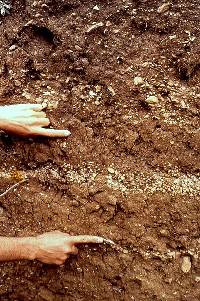
Pointing out the Paleoindian stratigraphy.
The upper hand points to the "Folsom" zone,
the layer within which the main Paleoindian component
occurred at Pavo Real. The bottom hand points to a piece
of broken chert in a lower gravel lens. At least one
definitively man-made chert flake was found well beneath
the Clovis-age deposits.
|
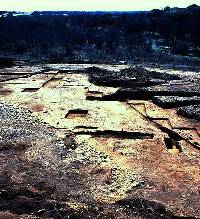
Late afternoon view looking southwest
across the Paleoindian excavations at Pavo Real with
Leon Creek on the right. This photograph was taken at
the end of the project.
|
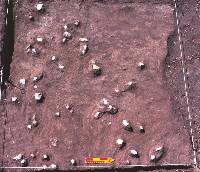
Paleoindian artifacts exposed in
a two-meter excavation unit at Pavo Real. After exposure,
the archeologists carefully plotted each item on a map.
|
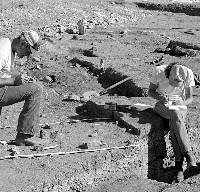
Archeologists Bob Stiba (left) and
Glenn Goode take notes and plot artifact locations during
the Paleoindian excavations.
|
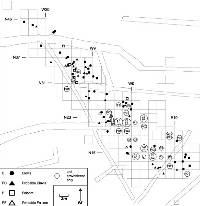
Distribution of artifacts that could
be assigned to Clovis and Folsom components. As this
map shows, the two assemblages occurred over essentially
the same areas. They were not separated vertically,
either.
|
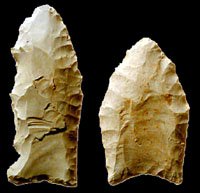
Clovis points from Pavo Real.
|
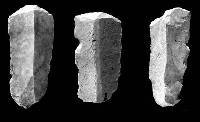
Clovis end scrapers made on blades.
|
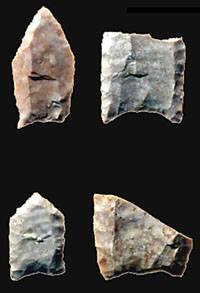
Miniature points (left) and two fragmentary
Folsom points (right).
|
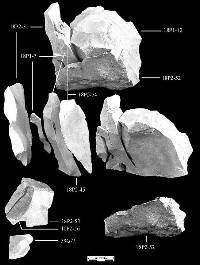
Refit Group 1 consisted of a core
and eight flakes that conjoined the core and one another.
This composite photo shows how the pieces fit together.
(The numbers are specimen numbers.)
|

Map showing the distribution of the
items found in Refit Group 2.
|
| |
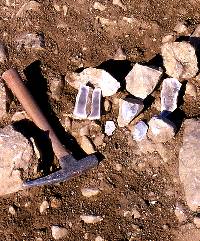 Natural chert cobbles from
the limestone "bench" at Pavo Real that have been split with a
geological hammer. The natural dark gray color of the PRVEC (Pavo Real Variety
Edwards Chert) can be seen in the center of the broken pieces. The outer
rinds are heavily patinated, or weathered. All of the site's Paleindian
artifacts were thoroughly patinated and appeared white. |

The Paleoindian excavations at Pavo
Real drew numerous visiting experts. Here TxDOT archeologist
Frank Weir points out a stratigraphic circumstance to
geologist Glen Evans (felt hat) and archeologist Dee
Ann Story (with camera). Jerry Henderson (solid red
shirt) and Chuck Johnson (dark brown shirt) look on.
|
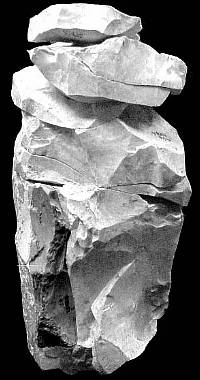
Refit Group 5 consisted of a blade
core, six core tablets and a blade. Here they are shown
fitted together. Core tablets are specialized flakes
that remove the top (platform) of a blade core in order
to create a new platform.
|
| |
| |
| |
| |
|
In early Paleoindian times (about 12,000-13,600
years ago) small groups of Clovis and Folsom
people camped at Pavo Real for short stays during which they
refurbished some of their tools and weapons from the abundant
supply of chert they found at the site. Clovis and Folsom
are the names of archeological cultures or cultural traditions
named by archeologists for their distinctive lanceolate spear
and dart tips (projectile points). The finding of a few artifacts
below the main Paleoindian layer at Pavo Real suggests that
the locality was visited by people at an even earlier time.
These may have been early Clovis people, although we are not
sure.
Although archeologists think that Folsom culture
succeeded Clovis culture, artifacts from the two cultures
were found in the same layer at Pavo Real and could not be
"stratigraphically separated." In other words, the
Folsom materials did not occur in a separate layer overlying
that containing the Clovis materials. Perhaps the Clovis and
Folsom occupations of the site (and these may well represent
more than two visits to the site) were not separated by very
much time. Alternatively, sediment accumulation may have been
so slow that Folsom peoples camped on the same surface as
had Clovis peoples in earlier times, such that the artifacts
from both were intermingled.
Throughout the Paleoindian occupations, knappers
made use of chert obtained at or very close to the site. Lithic
(stone) artifacts are essentially the only preserved cultural
evidence upon which we can base our interpretations of the
lives and activities of those who camped at Pavo Real. Techniques
of stone tool manufacture and aspects of stone tool use can
be inferred in some detail; from these inferences, the setting
of the site, and comparative data from other early Paleoindian
sites, limited interpretations can be made regarding broader
aspects of the prehistoric lifeways represented at this site.
Pavo Real was subject to repeated flooding
during the era in which the Paleoindian occupations occurred.
It is situated on the inside of a bend in Leon Creek on a
point bar in a region known for flash flooding. What is preserved
of the site is a flat terrace surface bounded on its east
by a low bedrock bench and on its west by a steep bank dropping
off toward the creek. At the time of the Clovis and Folsom
occupations, the site area was minimally 50 meters long and
40 meters wide (about 160 by 130 feet). Materials left by
these early occupants were buried by overbank flood deposits
across the flat terrace. It is likely that some evidence of
the early Paleoindian occupations was washed away at times
when high-energy floods eroded the creek bank.
In 1979-1980 when Pavo Real was dug, there was
little challenge to the Clovis First theory that Clovis
was the first North American culture or to the widely held
ideas that Clovis was succeeded over much of its range by
Folsom, and that the archeological remains left by both of
these were characteristic of nomadic big-game hunters. Clovis
hunters were thought to have preyed on mammoths and Folsom
hunters on now-extinct species of bison. It was often hypothesized
that early Paleoindian hunters may have been responsible for
the extinction of these members of the terminal Pleistocene
megafauna (large Ice-Age animals).
Excavations at Pavo Real began in the belief
that only Archaic archeological deposits were present, a view
that was reinforced when a seemingly artifact-free gravel
layer was encountered in test units below artifacts and features
of early Archaic age. Such gravels were (erroneously) considered
by the site's investigators to be the geologic marker of
the glacial maximum (peak of last Ice Age) at 17,000 or
18,000 years ago. Near the close of scheduled excavations,
a Clovis point was found at the base of the Archaic deposits.
A hurried testing ensued in search of additional Paleoindian
artifacts and these were, in fact, found. Most of these were
found within a flood deposit that was below the gravel then
thought to represent the glacial maximum.
The dig was extended, excavation strategy was
modified, and several experienced archeologists were added
to the field crew, but no specific research goals were identified
and pursued. Machines were used to remove the remaining Archaic
deposits above the layer (called the Folsom zone or Zone
5) bearing the Paleoindian artifacts. Zone 5 was excavated
by hand, and a high proportion of the exposed artifacts was
mapped in place. A number of these artifacts included diagnostics
(distinctive artifact types) matching Clovis and Folsom assemblages
at other, sealed sites.
In much the same way that Clovis and Folsom
Paleoindian artifacts were accidentally discovered beneath
the Archaic deposits, another component of unknown affiliation
was found by chance in deposits underlying the unit containing
Clovis and Folsom materials. This lowest cultural component
was barely investigated and too little was recovered to suggest
what affinities it might have to other early assemblages.
For the most part, it seems to date from early Clovis times.
(A single, apparently man-made flake was recovered from a
still deeper deposit that clearly predates Clovis, but it
is hard to say much about a single flake.)
Analysis Results
Two of the preliminary questions addressed by
Michael Collins and his research team at the Texas Archeological
Research Laboratory were: (1) Were the Clovis and Folsom materials
in primary context (where they were originally dropped)
or secondary context (moved and redeposited during
floods)? and (2) Was there evidence of any stratigraphic separation
between the Clovis and Folsom components?
There is no geologic evidence that the cultural
materials were transported from elsewhere and deposited together
(such as by stream or flood action), nor was there any indication
of a stratigraphic break or separation between Clovis and
Folsom materials. These geological inferences are entirely
consistent with the archeological evidence. The physical condition
of the artifacts do not indicate that they were transported
nor is there horizontal size-sorting suggestive of stream
transport; further, the Clovis and the Folsom artifacts exhibit
the same degree of patination (weathering) and surface damage.
The most compelling evidence for primary context is the large
number of refits, that is, artifact fragments that
fit together (conjoin), showing they were once part
of the same tool or were made from the same piece of chert.
The presence of pieces of large and small knapping debris
that conjoin one another and were found close together in
Zone 5 is a clear signature of artifacts in primary context.
Within Zone 5 there is no evidence of the vertical
separation of Clovis and Folsom artifacts. Geologically, Zone
5 accumulated intermittently over an unknown interval of time
beginning before and continuing after the majority of the
Clovis and Folsom artifacts were dropped. Probably the best
explanation for the component mixing at Pavo Real is that
natural deposition was slow enough for all of these cultural
materials to accumulate in a very few centimeters of sediment
but rapid enough that no stable surface formed.
Various techniques were used to date the Paleoindian
deposits and related geological layers at Pavo Real. Tiny
fragments of charcoal were found in the site's deeper and
earlier deposits, giving the original investigators hope that
these could be used to obtain radiocarbon age estimates of
the Paleoindian occupations. Unfortunately, the resulting
dates fell with early Archaic times, suggesting that the charcoal
was introduced into the lower deposits by pit-digging or other
disturbances. Years later, attempts to date snail shells (one
of the few organic materials that did survive) also were not
satisfactory for complicated reasons we won't go into. Finally,
a technique called OSL
(optically stimulated luminescence) dating was attempted.
OSL dating was more successful in that estimates for the absolute
ages of Zones 5, 7, and 9 were obtained. Unfortunately, this
dating technique does not yield precise age estimates and
results n rather wide ranges of possible ages.
It appears likely that the Paleoindian component
at Pavo Real was nearly totally excavated. Artifact counts
dropped off abruptly along the west, south, and east margins
of the excavated area. On the north, chert counts were still
high, but the proportion of these that were cultural in origin
was dropping off and the percentage of natural or stream-rolled
chert fragments was increasing. The exposed area of occupation
was roughly 50 m by 12 m. A majority of the artifacts were
found in a layer that was no thicker than 20 centimeters (8
inches).
To sum up the key findings regarding the Paleoindian
component at Pavo Real: (1) Clovis and Folsom artifacts were
found together in a loamy fluvial (water-laid) deposit with
no evidence for post-depositional (later) mixing or that they
accumulated on a stable land surface; (2) the Clovis and Folsom
artifacts were dispersed over an elongate area covering about
550 square meters (almost 6,000 square feet); (3) very little
of the Paleoindian component went unexcavated; (4) the Paleoindian
artifacts were buried by repeated overbank flooding of relatively
low energy; and (5) there is no indication that the stream
moved these artifacts prior to their burial.
Because of these factors, the Paleoindian artifacts
and two cultural features (both clusters of artifacts) can
only be attributed to the Clovis or to the Folsom component
on the basis of diagnostic features—lacking these, no
specific cultural assignment is possible. Collins made the
following assignments: there is 1 Clovis feature, 1 unassigned
feature, 145 Clovis artifacts, 57 Folsom artifacts, 99 unassigned
artifacts, and 22,933 pieces of unassigned debitage (roughly
16,000 debitage pieces are definitely cultural—the others
are probably natural fragments). There are also numerous large
stones scattered throughout the component that are too large
to have been moved by floodwaters without having also moved
lots of artifacts. Therefore, the majority of the large stones
are considered manuports, meaning they were carried
there by humans and perhaps used as anvil stones or weights
to hold down the edges of hide coverings.
Field investigators believed that the two Paleoindian
cultural features—concentrations of chipped stone—represented
distinct knapping events (occasions when one or more prehistoric
flint-workers sat down at the spot to produce or rework tools).
The first, Feature P3, consists of small, non-diagnostic flakes
from more than one piece of raw material. In the absence of
refits, there is no basis for attributing this cluster of
flakes to a single knapping event. The other, Feature P4,
consists of a core and various debitage pieces shown by refitting
to connect with a Clovis blade core and other debitage found
outside of the feature.
Pavo Real As A Lithic Workshop
Most of the behavioral evidence preserved and
recovered from the early occupational levels at Pavo Real
relates to the knapping of stone. This evidence is dominated
by tool-making debris produced by breaking up pieces of the
local variety of Edwards chert. While it seems likely that
the quality of the local chert was somewhat better (less weathered)
13,000 years ago than it is now, it was still plagued with
many flaws and a variety of textures. Consequences of the
flaws are evident throughout the knapping debris. In the general
region, better grades of Edwards chert were readily available
at the time to the people who camped at Pavo Real. Was Pavo
Real occupied because, or in spite of, the abundant but less-than-ideal
chert cropping out at the site?
The bulk of the Paleoindian assemblage from
Pavo Real is made up of non-diagnostic lithic debitage (generic
flakes, chips, and chunks of chert). Much of the evidence
stems from earlier stages of reduction in this material and
attests to similarities in the knapping process before the
distinctive pieces that characterize Folsom or Clovis take
form. There are also numerous simple tools such as unifaces
(shaped on only one face) and some bifaces (shaped on both
faces) that cannot be assigned to either Clovis or Folsom.
One curious set of Paleoindian artifacts consists
of four miniature lanceolate points that cannot be assigned
to Folsom or Clovis. Similar small-scale projectile points
have been found at other sites in Paleoindian contexts of
Clovis, Folsom, and Hell Gap cultures. The four miniature
pieces in this collection may include points made by knappers
of Clovis or Folsom affiliation, or both.
Clovis Lithic Technology
The majority (72%) of the 202 Paleoindian lithic
artifacts at Pavo Real that can be assigned to Clovis or Folsom
on the basis of morphology (shape) are of Clovis affiliation.
These include fluted projectile points, bifaces, bifacial
debitage, blade cores, blades, tools on blades, and blade
production debitage. The accompanying photographs provide
examples of most of these. The vast majority of the Clovis
artifacts are made on the local material.
All of the artifacts inferred to represent Clovis
biface technology (as opposed to blade technology)
relate to the production, use, maintenance, and discard of
fluted projectile points. There are two projectile points
that appear to have been discarded at the end of their usefulness.
Such pieces are typically found near sources of raw material
in association with evidence for point manufacture, exactly
the circumstances seen at Pavo Real.
Nine fragmentary Clovis bifaces found at Pavo
Real are consistent with the idea that the site was a workshop
where weapons were retipped. These fragments appear to be
Clovis point preforms (unfinished points) and a fragmentary
channel flake (specialized flake that creates the flute).
The bifaces are typical of unsuccessful attempts to produce
Clovis points.
There is substantial evidence for blade production
at Pavo Real. Both of the blade core forms, conical and wedge-shaped,
previously recognized in Clovis assemblages are present as
well as various kinds of blades, blade fragments, and blade-core
preparation flakes. The Clovis assemblage from Pavo Real also
includes blade tools such as end scrapers (blades with
one end that has been shaped into a circular tool edge). Most
of the end scrapers have a single notch on one edge, presumably
to facilitate hafting; they also have evidence of having been
resharpened.
Dale Hudler examined each of the blades tools
from Pavo Real under a microscope and found evidence of use
wear (such as edge damage and polish) on many of them. The
wear patterns he observed are considered characteristic of
contact with both plant and animal materials, with the latter
the more common. Such evidence shows that more went on at
the site than just tool making. The Clovis people who camped
here probably hunted nearby, butchered animals, gathered plant
foods, made tools or clothes out of leather and wood, and
so on.
Folsom Lithic Technology
Characteristic Folsom lithic artifacts present
at Pavo Real include fragmentary Folsom points, aborted Folsom
point preforms, channel flakes, thin retouched flakes, ultrathin
biface fragments, spurred end scrapers on flakes, large thin
unifaces, and multiple gravers. It is possible that some of
these could actually be of Clovis origins.
The Folsom artifacts at Pavo Real are exclusively,
or very nearly exclusively, made of the local chert. Most
of these pieces indicate that the Folsom knappers had problems
similar to those encountered by Clovis knappers. There are
multiple examples of knapping failures caused by flaws in
the raw material. Evidence for early stages in the Folsom
reduction technology were not identified in this assemblage.
This is almost certainly because they are not distinctive
enough to be recognized as such.
Two fragments of Folsom points were presumably
removed from their hafts and discarded at the site. Also present
is evidence of Folsom point manufacture. This is similar to
the Clovis assemblage at the site and is also inferred to
be the result of retooling (removing broken or worn out tools
from the wooden foreshafts of weapons and replacing these
with new ones). Folsom preforms exhibit a number of
failures, some resulting from knapping error and some from
insurmountable flaws in the raw material. The Folsom channel
flakes recovered from Pavo Real seem to have been successfully
detached, suggesting that completed Folsom points were probably
produced at the site from the local chert.
Bifaces other than preforms include two fragmentary
ultrathin bifaces and two thin flakes with bifacial pressure
flaking. Ultrathin bifaces, as the name suggests, are
large and extraordinarily thin bifaces thought to be cutting
tools (knives). Use-wear evidence confirming this function
was not found on the Pavo Real tools, perhaps because the
evidence for that use was removed by resharpening.
Numerous end scrapers on flakes from Pavo Real
exhibit the classic attributes of Folsom end scrapers. Thin
retouched flakes and flakes with multiple graver tips are
also considered to be of Folsom affiliation. The retouched
flakes may be cutting tools while the items called gravers
are too delicate to be used in the engraving of any durable
material such as wood or bone unless extremely lightweight
incisions were produced.
Pavo Real as a Paleoindian Site
At a general level of comparison, the Clovis
assemblage compares favorably with Clovis camp sites (as
opposed to kill sites and other specialized site types). In
Texas, at least five Clovis camp sites are indicated in the
ecotone along the Balcones Escarpment (Gault, Wilson-Leonard,
Vara Daniel, Spring Lake, and Kincaid—see map in "Site
and Its Investigations"). The emerging pattern seems
to be that of generalized hunter gatherers who would find
an ecotonal setting such as Pavo Real ideal for the variety
of resources that could be accessed with relatively little
travel. This idea contradicts the prevailing model of Clovis
peoples as highly mobile big game hunters.
Pavo Real is consistent with considerable data
that now exists on Clovis and on Folsom site distributional
patterns. Clovis site distributions and Clovis subsistence
data across North America reflect generalized hunting and
gathering lifeways, not big-game hunting specialization. To
some of us engaged in the search for the origins of human
occupancy of North America, it seems highly improbable that
this pattern represents the adaptation of the founding populations
of the continent (as expected according to the Clovis-First
theory). Clovis culture is simply too well adapted to diverse
resources in too many kinds of environments to be recent arrivals
to those environments.
In its consistency with Clovis site distributional
data, Pavo Real reinforces this emerging pattern. The
keystone in the interpretive model of rapid Clovis expansion
into an empty continent is that specialized big-game hunting
is transferable to any habitat where big game are present,
but when the evidence is preserved, most Clovis subsistence
is based on small animals and probably also included plants.
Clovis knappers were intimately familiar with tool stone sources
all over the continent, including some that were relatively
obscure. Their familiarity with the resources of the continent
looks more like the end product of many generations of exploration
and learning.
Folsom, on the other hand, seems to
be the archeological manifestation of a specialized big-game-hunting
way of life. This in itself poses a challenge to archeology
since ethnographic analogs are lacking (no comparable human
societies survive). Pavo Real as a Folsom site seems consistent
with the distributional pattern of other Folsom sites and,
in that sense, adds to what is known about Folsom subsistence
strategies. As scholars struggle to better understand a truly
nomadic big-game-hunting adaptation, this distributional pattern
will be pivotal.
Were the Clovis and Folsom components better
separated at Pavo Real, undoubtedly more could be said about
the structure of their camps and the nature of the activities
that transpired there. As it is, Pavo Real provides additional
evidence of the regional-scale land-use behaviors of Clovis
and of Folsom peoples. Pavo Real is probably also a strong
indication that Clovis and Folsom folk camped at numerous
localities in the Balcones Escarpment ecotone. Given the long
history and current pace of urban and suburban growth in this
part of Texas, to say nothing of 13,000 years of erosion,
many of these campsites undoubtedly have been lost and such
losses will continue.
There are deep alluvial deposits in the valleys
of larger streams where they emerge from the dissected edge
of the Edwards Plateau and change to a lower gradient along
the margin of the Gulf Coastal Plain. These are precisely
the settings where early sites have a better chance of survival
because they are deeply buried. Sites formed in such settings,
where rapid rates of deposition would favor better component
isolation, would also have better conditions for preservation
of such materials as bone.
Concerted geoarcheological reconnaissance along
the alluviated valleys of such rivers as the Brazos, Little,
San Gabriel, Colorado, San Marcos, Guadalupe, Medina, Sabinal,
Frio, and Nueces as well as lesser streams along the Balcones
Escarpment ecotone should identify areas where latest Pleistocene
to earliest Holocene age deposits exist. Additional Clovis
and Folsom sites will likely be found well-preserved and stratigraphically
well-isolated in these settings. Such sites have the potential
to expand and refine our understanding of Clovis and Folsom
adaptations as expressed in the Balcones Escarpment ecotone
and glimpsed at Pavo Real.
|
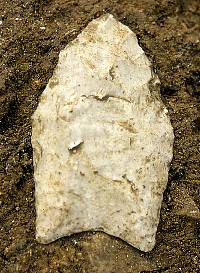
Clovis point as it was found at Pavo
Real.
Click images to enlarge
|
FAQ: What are
assemblages and components?
Assemblages are groups of artifacts
made and left behind.... read
more>> |
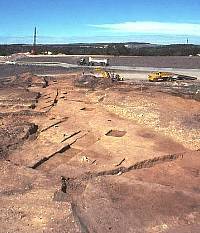
View north-northwest along long axis
of Paleoindian deposits. The limestone bench that bounds
the east side of the occupation area stands out clearly.
|
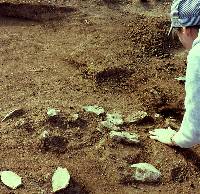
Archeologist uncovers the concentration
of Paleoindian artifacts at Pavo Real designated as
Folsom Feature 4 (Iater renamed Feature P4).
|
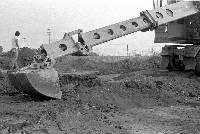
Gradall at work removing the Archaic
deposits overlying the Paleoindian component, Fall 1979.
|
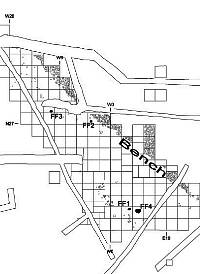
Distribution of Paleoindian features
as recorded during the field investigations. FF stands
for Folsom Feature. FF1 and FF2 were rejected as valid
cultural features during the analysis. The remaining
two features are clusters of knapping debris. Also shown
is the location of the limestone bench and numerous
manuports, large rocks obviously moved to these locations
by humans.
|

Large, partially reassembled chert
mass that Clovis knappers had broken apart at Pavo Real
early in the process of creating a blade core.
|
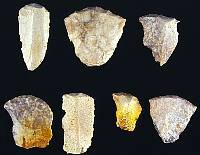
Selection of end scrapers made on
flakes and on blades. Those on blades are probably of
Clovis origin whereas those on flakes could be of either
Clovis or Folsom affiliation.
|
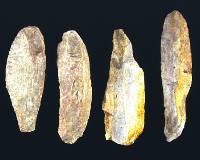
Selection of Clovis blades, including
some used as tools with little or no modification.
|
| |
|
FAQ: What is
lithic reduction?
Lithic reduction (or just reduction)
is the process of taking a relatively large, shapeless
piece of chert and... read
more>>
|

Refit Group 2 consisted of a blade
core, four core tablets, two platform preparation flakes,
and six blade fragments that have been refitted as shown.
|

Refit Group 4 consisted of an irregular
core and several flakes that conjoined the core and
one another. This composite photo shows the reassembled
piece and how the pieces fit together. (The numbers
are specimen numbers.)
|
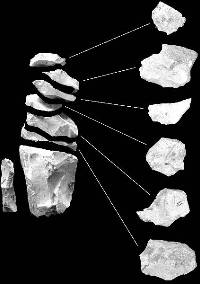
Refit Group 5 disassembled. Compare
with photo, below left.
|
| |
| |

Jerry Henderson looks on
as a Gradall is used to remove Archaic deposits overlying the Paleoindian
component. |
|